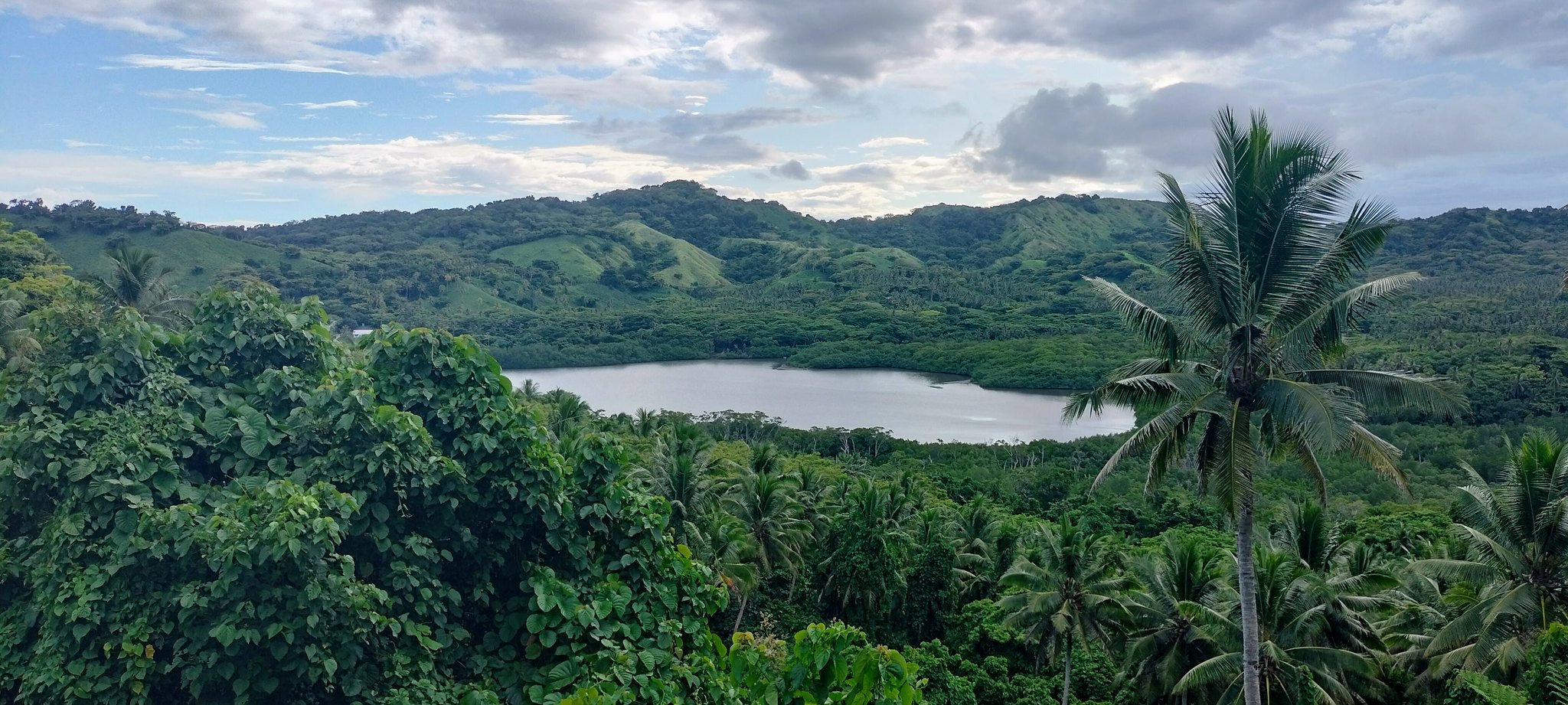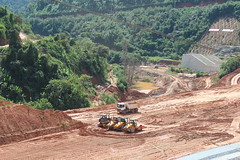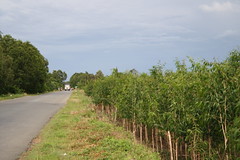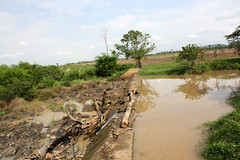Photographs
View some of our recent photographs here in these galleries.
Assessment for Mainstreaming Nature-Based Solutions (NbS) in the Water Supply Sector in Cambodia
In recent years, strengthening the resilience of water sources and supply has been a top priority for emerging towns and rural growth centres in Cambodia. Nature-based solutions (NbS) are an essential and cost-effective strategy for increasing resiliency to these stressors and generate a variety of co-benefits beyond the water sector by supporting poverty alleviation, community health and wellbeing, biodiversity protection, and climate mitigation. NbS, including Green Infrastructure (GI), are increasingly being integrated into water management strategies as standalone and hybrid measures to provide flexible and durable improvements to water supply, storage, regulation, and quality services. Examples of nature-based solutions are presented in Figure 1. They are relatively fast to implement and scale up and often have lower technology requirements and costs. NbS delivery can be highly decentralized, engage local communities and beneficiaries in their implementation, draw on the use of local materials and lead to healthy places, promoting ecological and social recovery and resilience.
> Discover more about the project
The photos in this album are from a first field mission by Boeung Khnar Lake, conducted in June 2022.
Assessment of Needs and Opportunities to Improve Ecosystem Resilience and Sustainable Tourism in Fiji
Fiji faces unique challenges – being far from major markets, geographically fragmented and among the world’s most vulnerable to climate change. At the same time, Fiji has unique opportunities presented by the Blue Economy in sectors such as tourism and fisheries. With long stretches of sandy beaches, tropical forests and extensive coral reefs, Fiji often ranks as the most popular tourist destination out of all Pacific Island Countries. Tourism is the primary export earner, contributing approximately 34% to GDP in 2018.
Despite the impacts of COVID-19, which have threatened businesses, livelihoods and economic growth, the country remains committed to tourism due to its importance to national economies and jobs.
The photos in this album are from a second field mission to Suva and Vanua Levu, conducted in 2022.
Disaster preparedness pilot project in Bhutan
Bhutan is highly susceptible to natural hazards due to the country’s unstable geological conditions, steep terrain, elevation differences, variable climatic conditions and proximity to the seismically active Himalaya mountain range. Hazards include floods, heavy rainfall, landslides, earthquakes, glacial lake outburst floods (GLOF), forest fires, droughts and earthquakes. Several strong earthquakes above magnitude 6.0 have occurred over the past century.
Through the Disaster Preparedness Pilot Project (DPPP), funded by the Swiss Red Cross, ICEM is supporting the Department of Disaster Management address these challenges by improving the country’s capacity and systems on contingency planning and preparedness for earthquakes and seismic risk.
> Visit the Disaster Preparedness Pilot project page
The photos in this album are from an initial scoping mission and a seismic risk assessment workshop, conducted in 2018.
Improving the resilience of Nepal’s strategic roads network
In Nepal, the construction of local roads, highways, and forest roads in river basins and mountainous areas leads to higher rates of erosion and sedimentation. This can have the potential to be a significant trigger of landslides. Risks are exacerbated by the challenging terrain, young geology of the Himalayan mountains, and annual monsoon rainfall in the country. To expand the current landslide risk assessments in Nepal and engage on climate and disaster risk across India and Nepal, the Geohazard risk management and resilient road asset management in Nepal project was launched.
The photos featured in this album are from a field mission to assess road criticality as part of the goal of improving the resilience of strategic road networks.
> Visit the Geohazard risk management and resilient road asset management in Nepal project page
The Mekong River – Golden Triangle to Luang Prabang
The Mekong River is one of the world’s great river systems, flowing 4,909 km through six countries: China, Myanmar, Thailand, Lao PDR, Cambodia, and Viet Nam. The river basin’s biodiversity is immense, and fundamental to the viability of natural resource-based rural livelihoods of a population of 60 million people living in the Lower Mekong Basin.
The river is also an important resource for economic development. Phase 1 of the Development Plan of International Navigation on the Lancang-Mekong River (LMDP) aims to improve navigation in the Mekong mainstream from the Golden Triangle to Luang Prabang. Projects include the development of three cargo ports at Xiengkok, Pak Beng and Luang Prabang in Laos; the improvement and maintenance of rapids and shoals; and the construction of four emergency response and rescue ships and aids to navigation.
The environmental study aims to engage riparian communities, MRC member countries and local government in an exploration of the potential environmental impacts of the LMDP, and to support Mekong countries in ensuring that these are managed through appropriate enhancement and mitigation measures.
This photo album showcases selected features of the Mekong River from the Golden Triangle to Luang Prabang.
Myanmar Healthy Rivers Initiative (MHRI)
Understanding river health requires monitoring of spatio-temporal trends in the ecological condition of the river and its capacity to continue to provide the users with the goods and services they value. The MHRI tailored a River Health Framework suitable for Myanmar, where conventional river monitoring is rarely available and government and community stakeholders need to draw on alternatives.
The project explored new opportunities for monitoring river health from space (remote sensing, global data sets) and from the riverbank (community-led citizen science techniques).
A key question driving the MHRI project was how community based river health monitoring could be used to complement official/conventional monitoring. To help answer this question, the MHRI team assessed river uses, ecosystem services and trends in six communities, three on the Ayeyarwady River, and three on the Thanlwin River.
This album documents some of the fieldwork conducted for the project.
MK3: Optimizing the management of a cascade of reservoirs at the catchment level
MK3 aimed at identifying the potential for multiple use of water in cascades of hydropower reservoirs, and at making suggestions for coordinated and equitable management of these uses. The three-year research program, conducted between 2010 and 2013, took place in two river basins -the Nam Theun/Nam Kading and Lao PDR and the Sesan River in Vietnam and Cambodia.
> Visit the Optimizing the management of a cascade of reservoirs at the catchment level project page
Promoting Climate Resilient Rural Infrastructure in Northern Vietnam – field trip to Thai Nguyen
The photographs in this slideshow were taken as part of ICEM team’s field trip to Thai Nguyen, Vietnam in July 2016 for the ADB project Promoting Climate Resilient Rural Infrastructure in Northern Vietnam. The photographs focus on the bioengineering techniques used to protect and stabilise roadside slopes at the demonstration site in Thai Nguyen. The plants are growing well, creating a beautiful picture while increasing resilience to core infrastructure.
> Read the most recent report on ICEM’s Bioengineering Workshop: Designs and Construction (Roads)
> Read more about the project Promoting climate resilient rural infrastructure in Northern Vietnam
Khone Falls – Fish Pass Study, Champasak Province Lao PDR
These photos were taken with a drone as part of a project completed in 2015 which was the first of its kind for the Mekong River. The study provided the foundation for understanding fish migration dynamics to inform realistic and sustainable design of fish passes for proposed hydropower dams. The project aimed to assess the hydro-geomorphologic requirements of fish migrations using the Khone Falls as a natural laboratory.
Nam Ngiep 1 Site Inspection
In October 2014, the ICEM project team together with representatives from the Nam Ngiep company assessed the build site.
The overall objective of the study was to assess the climate risk of the proposed Nam Ngiep 1 Hydropower Project (NNP1) in Lao PDR, and to identify measures to increase its climate resilience.
Mekong Delta Decision Support Framework Field Trip
In September 2014, the DELTA DSF project team took a four-day, 1100 km trip through the Mekong Delta to learn about how water infrastructure, farming decisions, and seasonal flooding affect the Delta’s inhabitants.
It is becoming increasingly important to understand how and where climate impacts will be felt. How will changes to flooding and salinity impact today’s infrastructure decisions? Can we incorporate climate modelling into agricultural decisions? The field trip gave project team members a chance to see where these changes will play out and to speak to the people who live, work, and make decisions in the Delta.
> Read more about the Mekong Delta Decision Support Framework
2013 Fieldtrips for the AusAID / CIGIAR funded project – The Impact of Water Supply Infrastructure on Floods and Droughts in the Mekong Region and the Implications for Food Production under the Mekong Challenge Program on Water and Food (MK12)
These photographs show water supply infrastructure near the villages of Srepok, Ea Mar and Drek B. They also show the community consultations with local communnities. Mekong River hydrology has been altered by the expansion of Water Supply Infrastructure (WSI) for 20 years. However, having been designed and managed for regular climate, the performance of these WSI in managing extremes in hydro-climate is not well understood. Through research, modelling, surveys, community consultations, site visits and case studies, this project is set to improve the understanding of the impact of WSI on managing floods and droughts and the downstream consequences for agricultural productivity and food security. The expected outcome of the project is that the impact of WSI on flood and drought and the linked implications for food security in the Mekong region are better understood.
Nepal fieldtrip for Mainstreaming Climate Change Risk Management into Development in Nepal – July 2013
These photographs were taken in Nepal by the ICEM team working on the ADB project Mainstreaming Climate Change Risk Management into Development in Nepal. ICEM is working with seven national government agencies responsible for infrastructure development throughout the country, such as irrigation, roads and bridges, flood and river management and water supply and sanitation. Natural disasters such as major floods, landslides, river bank collapse and flash flooding regularly damage and destroy critical infrastructure and cause loss of life and property. Those challenges are projected to become more severe with climate change. Several of these photograhs demonstrate the vulnerable aspects of infrastructure and water supply for local communities in the eight project districts. They also illustrate some program workshops and team activities.
> Read more about Mainstreaming Climate Change Risk Management into Development in Nepal
Promoting Climate Resilient Rural Infrastructure in Northern Vietnam – bioengineering research field trip 2013
The photographs in this slideshow were taken as part of research studies in Northern Vietnam for the ADB project Promoting Climate Resilient Rural Infrastructure in Northern Vietnam. The photographs focus on rural irrigation, slope stability for roads, river-bank protection, and flood protection works. They demonstrate some critical aspects of vulnerable infrastructure at the project sites.
The objective of the project in Northern Vietnam is to demonstrate effective bio-engineered solutions which, where possible, provide ‘win-win’ outcomes for resilience of rural infrastructure to climate risk and opportunities for community livelihood enhancement. The project will raise awareness of climate risks and vulnerabilities in local communities and empower them with the capability to manage risk through practical, cost effective solutions which can be implemented with local resources.
> Read more about Promoting Climate Resilient Rural Infrastructure in Northern Vietnam














